The availability of dicamba-tolerant soybean this season increases the need for emphasis on proper maintenance and thorough cleanout of the sprayer system between applications; especially POST applications. The likely introduction of additional herbicide-tolerant traits in the future indicates that sprayer maintenance and cleanout will continue to be an essential focal point to avoid tank contamination and injury to subsequently sprayed crops.
One specific concern about dicamba and 2,4-D in the spray tank is that although they are water soluble, similar to glyphosate, they act as weak acids and require more effort and care in effectively being removed from the spray tank. Additionally, glyphosate is very effective in dissolving remnant dicamba residue left in the sprayer.
So the scenario in which: dicamba is in the spray tank and applied, followed by improper cleanout of the sprayer, followed by glyphosate being added to the tank and then applied to non-dicamba soybean; is likely going to result in injury to the non-dicamba tolerant soybean.
It is not just about the tank
Overall sprayer maintenance and cleanout is important. Researchers at Mississippi State University recently published results where they studied combinations of spray line types and cleanout practices to determine which were most likely to perform best and leave the least amount of dicamba residue to contaminate subsequent spray mixes. They compared 5 types of hose (Table 1). Dicamba and glyphosate were added to each hose. The hoses were drained and cleaned with either water or an ammonia solution or not cleaned at all for comparison. The researchers found that the type of hose mattered more than whether ammonia or water was used for cleaning. The black, Goodyear hose retained the most dicamba regardless of the cleanout procedure used. Amounts of dicamba in the Goodyear hoses were similar between the ammonia rinse and no cleanout and only slightly less with water. The John Deere blue, low-density polyethylene hose held the least amount of dicamba at less than 1 ppm when washed with either water or ammonia. Detectable dicamba in the other three hoses fell in between the Goodyear and John Deere polyethylene blend, and detected levels did not change regardless of whether ammonia or water was used for cleaning the tank. The scientists cut open the tubes following the experiments to look at wear and tear on the inside of the lines using a specialized microscope. As might be expected, the black Goodyear hose had the most wear and tear over the three years of the experiments and the polyethylene hose had the least.
 Table 1: Node reduction (%) on non-dicamba tolerant soybean plants treated with glyphosate from a tank that had previously been filled with dicambaa.
Table 1: Node reduction (%) on non-dicamba tolerant soybean plants treated with glyphosate from a tank that had previously been filled with dicambaa.
But what does all this mean?
The wear and tear in the hoses provides opportunity for dicamba to settle and escape cleaning. We know from some of our earlier research that it only takes a very small amount of dicamba to injure non-tolerant soybean so any time there is dicamba left in any of the sprayer parts prior to spraying non-dicamba tolerant crops, it is concerning. The Mississippi State researchers who conducted the spray line study added glyphosate to the spray lines following cleanout and then sprayed non-tolerant soybean to represent a subsequent, sensitive crop. They found that soybean node reduction (Table 1) seemed to be affected by the amount of dicamba detected in the lines following cleanout. The more dicamba detected in the lines, the less nodes on the subsequently, sprayed non-tolerant soybean and consequently less yield.
This study emphasizes proper maintenance and cleanout of the spray lines, especially following application of dicamba and 2,4-D, is just as important as maintenance of the entire tank. Last year we surveyed over 2,300 pesticide applicators in Missouri. Of applicators willing to share information on spray tank inspection and cleanout, over 69% responded that they inspected spray parts a minimum of once per week although only about 60% of those who regularly check said they inspect spray lines. Approximately 48% of respondents indicate they clean the spray tank three times following application of one herbicide and prior to mixing another herbicide. These procedures may have worked fine in recent years when applying glyphosate over large acreages; however, from now on we need to improve our alertness and effort in caring for the sprayer in order to minimize off-target herbicide injury to soybean. In addition to the spray tank and lines, it is equally important to check the inductor, endcaps, nozzles, and filters for particulates.